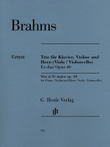Chamber Music Horn, Piano, Violin
SKU: PR.114414920
Composed by Eric Ewazen. Sws. Contemporary. Score and parts. With Standard notation. 64 pages. Duration 21 minutes. Theodore Presser Company #114-41492. Published by Theodore Presser Company (PR.114414920).
ISBN 9781598067842. UPC: 680160598472. 9 x 12 inches.
Commissioned by Chamberosity, Eric Ewazen’s Trio for Horn, Violin, and Piano pays homage to Brahms’ work for the same instruments. Ewazen’s four movements are modeled after the Brahms, with a slow-fast-slow-fast scheme. A mysterious first movement accumulates depth and momentum, then returns to the gentle world of the opening. The second movement is a rip-roaring scherzo, with melodies tossed between the violin and horn. The melancholy third movement features long lyric melodies, and the final movement, following an austere introduction, turns into a grand fugue, full of life and excitement. For advanced performers.
Commissioned by and gratefully dedicated to Chamberosity, this piece represents an homage to one of my favorite chamber pieces of all time, the Trio for Horn, Violin, and Piano by Brahms. Having both performed (on piano) and analyzed that work, I so loved Brahms’ wonderful weaving of the colors of the instruments, creating an almost orchestral color palette. For years I have wanted to write a trio for the same combination, and when my friends in Chamberosity were enthusiastic about me writing that piece for them, I was delighted.The four movements are modeled after the Brahms, with a slow-fast-slow-fast scheme to the entire work. A gentle, somewhat mysterious first movement accumulates depth and momentum as it proceeds, only to return to the gentle world of the opening. The second movement is a rip-roaring scherzo, a true energetic dance with melodies tossed back and forth from the violin to the horn, while the piano provides a resonant accompaniment, inserting its own lively melodies as counterpoint to the violin and horn. The third movement is filled with melancholy, with long lyric melodies appearing sometimes as solos, sometimes as duets, and sometimes as a chorale with all three instruments singing their soulful songs. The final movement, following an austere, dramatic introduction, turns into a grand fugue, with a jumping fugue theme full of life and excitement, culminating in the themes heard in augmentation, strong and bold.



























































